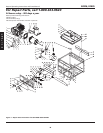
3
E
N
G
L
I
S
H
Models 2ZRP8, 2ZRP9
Dayton Operating Instructions and Parts Manual
Install battery-operated carbon
monoxide alarms or plug-in carbon
monoxide alarms with battery back-
up in your home, according to the
manufacturer’s installation instructions.
The carbon monoxide alarms should
be certified to the requirements of
the latest safety standards for carbon
monoxide alarms. (UL 2034, IAS 6-96, or
CSA 6.19.01).
Test your carbon monoxide alarm
frequently and replace dead batteries.
SAFETY WARNING WHEN REFUELING
Gasoline is extremely flammable and its
vapors can explode if ignited.
Observe all safety regulations for the
safe handling of fuel. Handle fuel in
safety containers. If the container does
not have a spout, use a funnel.
Do not overfill the fuel tank, leave
room for the fuel to expand.
Do not refill fuel tank while the
engine is running. Before refueling the
generator, turn it off and let it cool
down. Gasoline spilled on hot engine
parts could ignite. Fill the tank only on
an area of bare ground. While fueling
the tank, keep heat, sparks and open
flame away. Carefully clean up any
spilled fuel before starting engine.
Always fill fuel tank in an area with
plenty of ventilation to avoid inhaling
dangerous fumes.
NEVER store fuel for your generator in
the home. Gasoline, propane, kerosene,
and other flammable liquids should
be stored outside of living areas in
properly-labeled, non-glass safety
containers. Do not store them near
a fuel-burning appliance, such as a
natural gas water heater in a garage. If
the fuel is spilled or the container is not
sealed properly, invisible vapors from
the fuel can travel along the ground
and can be ignited by the appliance’s
pilot light or by arcs from electric
switches in the appliance.
GROUND FAULT CIRCUIT INTERRUPTER
PROTECTION. These generators are
equipped with two GFCI (Ground
Fault Circuit Interrupters) 120V duplex
receptacles for protection against
the hazards of electrical shock from
defective attachments such as, tools,
cords, and cables.
A GFCI is a device that interrupts
electricity from either the utility or
generator by means of a special type of
circuit breaker if a fault current flow to
the ground occurs.
A GFCI can be used only with generators
that have the neutral wire internally
bonded to the frame, and the frame
properly grounded to the earth. A GFCI
will not work on generators that do not
have the neutral wire bonded to the
frame, or on generators which have not
been properly grounded. All Dayton
generators have internally bonded
ground wires. A GFCI will not work if
the unit is not properly grounded.
A GFCI may be required by OSHA
regulations, the National Electric Code
and/or local and federal codes when
operating a generator.
For additional protections against shock
hazards due to defective equipment
attached to the twist-lock receptacles,
consider the use of a GFCI on each of
these receptacles as well.
GFCIs and GFCI protected cord sets and
cables may be purchased from local
electrical supply houses.
The GFCIs may not
function unless
the generator is properly grounded.
Follow the correct procedure specified
in the section labeled “GROUNDING
INSTRUCTIONS”
Only the 120V
Duplex Receptacles
are protected by the GFCI.
ELECTRICAL HAZARDS. This product
must be grounded. If it should
malfunction or breakdown, grounding
provides a path of least resistance for
electric current to reduce the risk of
electric shock.
Improper connection
of the equipment-
grounding conductor can result in a risk
of electrocution. Check with a qualified
electrician or service person if you
are IN doubt as to whether the unit is
properly grounded.
This generator is equipped with a
grounding terminal for your protection.
Always complete the ground path from
the generator to an external ground
source as instructed in the section
labeled “Grounding Instructions” in the
Preparation section of this manual.
The generator is a potential source of
electrical shock if not kept dry. Keep
the generator dry and do not use in
rain or wet conditions. To protect from
moisture, operate it on a dry surface
under an open, canopy-like structure.
Dry your hands if wet before touching
the generator.
Risk of electric shock if you operate
this generator with a faulty GFCI
(Ground Fault Circuit Interrupter). Test
GFCI before each use, see Operations
Instructions for further information.
If GFCI fails test, DO NOT use your
generator. Contact your Dayton
Customer Service Representative.
Plug appliances directly into the


















